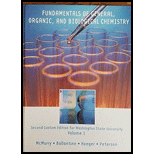
(a)
Interpretation:
The equilibrium constant for the following reaction has to be determined.
Concept Introduction:
Equilibrium constant is explains the relationship among reactant and product at equilibrium for a particular reaction.
The equilibrium constant expression is expressed by the formula,
It is the ratio of concentration of product raised to power of their corresponding coefficient of stoichiometry and concentration of reactant raised to power of their corresponding coefficient of stoichiometry at equilibrium.
(b)
Interpretation:
K for the given reaction at
Concept Introduction:
Equilibrium constant:
It is the ratio of products to reactants has a constant value when the reaction is in equilibrium at a certain temperature. And it is represented by the letter K.
For a reaction,
The equilibrium constant is,
where,
a, b, c and d are the
If
Want to see the full answer?
Check out a sample textbook solution
Chapter 7 Solutions
Fundamentals Of General, Organic, And Biological Chemistry Volume 1 Second Custom Edition For Washington State University, 2/e
- The phosphoryl group transfer potentials for glucose-1-phosphate and glucose-6-phosphate are 20.9 kJ/mol and 13.8 kJ/mol, respectively. (a) What is the equilibrium constant for the reaction shown below at 25 °C? (b) If a mixture was prepared containing 1 m glucose-6-phosphate and 1 x 10-3 M glucose-1-phosphate, what would be the thermodynamically favored direction for the reaction?arrow_forwardCalculate ΔG° (answer in kJ/mol) for each of the following reactions from the equilibrium constant at the temperature given. (d)CoO(s)+CO(g)⇌Co(s)+CO2(g) T=550°C Kp=4.90×102 (e)CH3NH2(aq)+H2O(l)⟶CH3NH3+(aq)+OH−(aq) T=25°C Kp=4.4×10−4 (f)PbI2(s)⟶Pb2+(aq)+2I−(aq) T=25°C Kp=8.7×10arrow_forwardThe formation constants at 25°C for Fe(CN)4-6 and Fe(EDTA)2– are 1.00 x 1037 and 2.10 x 1014, respectively. Answer the questions below. 1) Calculate K under standard conditions for the reaction Fe(EDTA)2−(aq) + 6CN−(aq) ----> Fe(CN)4−6(aq) + EDTA4−(aq) 2) Calculate ΔG° for the reaction. (kJ/mol)arrow_forward
- Calculate ΔG for the reaction H2O(l) ⇆ H+(aq) + OH−(aq) at 25°C for the following conditions. [H+] = 3.1 M, [OH−] = 4.7 ×10−4 Marrow_forwardA reaction at 23°C has ∆G = 1 kJ mol–¹. Why might this reaction become spontaneous at 37°C?arrow_forwardPotassium superoxide, KO2, is used in rebreathing masks to generate oxygen according to the reaction below. If the mask contains 0.250 mol KO2 and 0.200 mol water, what is the limiting reagent? How many moles of excess reactant will there be once the reaction is complete? 4 KO2(s) + 2 H2O(ℓ) → 4 KOH(s) + 3 O2(g)arrow_forward
- Assume that the reaction Arabinose +Pi <> Arabinose-6-P has a delta G of +13.0 kJ/mol and the reaction XTP <> XDP + Pi has a delta G of -25.7 kJ/mol. Calculate the delta G for the combined reaction Arabinose + XTP <> Arabinose-6-P + ADP, in kJ/mol to four significant figures.arrow_forwardFor the series of reactions below, what is the overall reaction and the value of ∆Go’(kJ/mol) for this set of reactions? Is the reaction spontaneous? (1) 2 Pi+ H2O ➔Pyrophosphate+ H2O (with 5 mM Mg2+) (2) (Mg)Pyrophosphate + AMP ➔(Mg)ATP (3) (Mg)ATP + creatine ➔creatine-phosphate + (Mg)ADParrow_forwardTwo solutions, 250.0 mL of 1.00 M CaCl2(aq) and 250.0 mL of 1.00 M K2SO4(aq), are combined, and the temperature decreased by 2.40 degrees C. Determine qrxn per mole of CaSO4(s) formed in the reaction. A) +12.0 kJ/mol B) -12.0 kJ/mol C) +6.00 kJ/mol D) -6.00 kJ/molarrow_forward
- which statement is true for the following reaction?arrow_forwardFor the following reactions, identify the atom(s) being oxidized and reduced:arrow_forwardCalculate the Keq (report up to two decimal places and do not use scientific notation) for the net reaction at 298.15K. (see attached image) Note: R = 1.98 x 10 -3 kcal/mol-Karrow_forward
 BiochemistryBiochemistryISBN:9781319114671Author:Lubert Stryer, Jeremy M. Berg, John L. Tymoczko, Gregory J. Gatto Jr.Publisher:W. H. Freeman
BiochemistryBiochemistryISBN:9781319114671Author:Lubert Stryer, Jeremy M. Berg, John L. Tymoczko, Gregory J. Gatto Jr.Publisher:W. H. Freeman Lehninger Principles of BiochemistryBiochemistryISBN:9781464126116Author:David L. Nelson, Michael M. CoxPublisher:W. H. Freeman
Lehninger Principles of BiochemistryBiochemistryISBN:9781464126116Author:David L. Nelson, Michael M. CoxPublisher:W. H. Freeman Fundamentals of Biochemistry: Life at the Molecul...BiochemistryISBN:9781118918401Author:Donald Voet, Judith G. Voet, Charlotte W. PrattPublisher:WILEY
Fundamentals of Biochemistry: Life at the Molecul...BiochemistryISBN:9781118918401Author:Donald Voet, Judith G. Voet, Charlotte W. PrattPublisher:WILEY BiochemistryBiochemistryISBN:9781305961135Author:Mary K. Campbell, Shawn O. Farrell, Owen M. McDougalPublisher:Cengage Learning
BiochemistryBiochemistryISBN:9781305961135Author:Mary K. Campbell, Shawn O. Farrell, Owen M. McDougalPublisher:Cengage Learning BiochemistryBiochemistryISBN:9781305577206Author:Reginald H. Garrett, Charles M. GrishamPublisher:Cengage Learning
BiochemistryBiochemistryISBN:9781305577206Author:Reginald H. Garrett, Charles M. GrishamPublisher:Cengage Learning Fundamentals of General, Organic, and Biological ...BiochemistryISBN:9780134015187Author:John E. McMurry, David S. Ballantine, Carl A. Hoeger, Virginia E. PetersonPublisher:PEARSON
Fundamentals of General, Organic, and Biological ...BiochemistryISBN:9780134015187Author:John E. McMurry, David S. Ballantine, Carl A. Hoeger, Virginia E. PetersonPublisher:PEARSON





